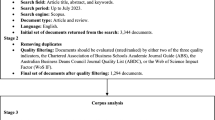Abstract
The study of cognitive biases in decision-making has largely arisen within the context of the subjective expected utility school of decision analysis. Many of the behavioural patterns that have been discovered do seem to be relevant to broader areas of multicriteria decision analysis (MCDA). In this paper, we look specifically at the judgemental inputs required in implementing goal programming (GP) models. The potential relevance of some of the known cognitive biases in this context are identified, and their impact studied by means of simulation experiments. It is found, inter alia, that biases due to anchoring and adjustment and to avoidance of sure loss can lead to substantial degradation in the performance of GP algorithms. Suggestions for practice and recommendations for follow-up research are derived from the simulation results.
Similar content being viewed by others
References
Lee SM and Olson DL (1999). Goal programming. In: Gal T, Stewart TJ and Hanne T (eds). Multicriteria Decision Making: Advances in MCDM Models, Algorithms, Theory, and Applications. Kluwer Academic Publishers: Boston, Chapter 8.
Romero C (1991). Handbook of Critical Issues in Goal Programming. Pergamon Press: Oxford.
Tamiz M, Jones D and Romero C (1998). Goal programming for decision making: an overview of the current state-of-the-art. Eur J Opl Res 111: 569–581.
Wierzbicki AP (1999). Reference point approaches. In: Gal T, Stewart TJ and Hanne T (eds). Multicriteria Decision Making: Advances in MCDM Models, Algorithms, Theory, and Applications. Kluwer Academic Publishers: Boston, Chapter 9.
Ignizio JP and Romero C (2002). Goal programming. In: Bidgoli H (ed). Encyclopedia of Information Systems, Vol 2, 489–500. Academic Press: New York.
Schniederjans MJ (1995). Goal Programming: Methodology and Applications. Kluwer: Boston.
Tamiz M, Jones DF and El-Darzi E (1995). A review of goal programming and its applications. Ann Opns Res 58: 39–53.
Stewart TJ (1999). Evaluation and refinement of aspiration-based methods in MCDM. Eur J Opl Res 113: 643–652.
Simon HA (1976). Administrative Behavior, 3rd edn. The Free Press: New York.
Galotti K (2002). Making Decision That Matter. Lawrence Erlbaum Associates: Maywah, NJ.
Keeney RL (1992). Value-Focused Thinking: A Path to Creative Decision Making. Harvard University Press: Cambridge, MA.
Bazerman MH (2002). Judgment in Managerial Decision Making 5th edn. John Wiley & Sons: New York.
Ignizio JP (1983). Generalized goal programing: an overview. Comput Opns Res 10: 277–289.
Bertomeu M and Romero C (2002). Forest management optimisation models and habitat diversity: a goal programming approach. J Opl Res Soc 53: 1175–1184.
Stewart TJ (1991). A multicriteria decision support system for R&D project selection. J Opl Res Soc 42: 17–26.
Buchanan JT (1994). An experimental evaluation of interactive MCDM methods and the decision making process. J Opl Res Soc 45: 1050–1059.
Benayoun R, de Montgolfier J, Tergny J and Larichev O (1971). Linear programming with multiple objective functions: step method (STEM). Math Programm 1: 366–375.
Masud ASM and Hwang CL (1981). Interactive sequential goal programming. J Opl Res Soc 32: 391–400.
Kahneman D and Tversky A (1979). Prospect theory: an analysis of decision under risk. Econometrica 47: 263–291.
Tversky A and Kahneman D (1981). The framing of decisions and the psychology of choice. Science 211: 453–458.
Stewart TJ (1988). Experience with prototype multicriteria decision support systems for pelagic fish quota determination. Naval Res Logist 35: 719–731.
Stewart TJ (1996). Robustness of additive value function methods in MCDM. J Multi-Criteria Decis Anal 5: 301–309.
Acknowledgements
This work was partly carried out while the author was visiting professor at the Leeds University Business School, Leeds LS2 9JT, England. The hospitality and financial support from LUBS as well as useful discussions with John Maule and Clare Harries are gratefully acknowledged.
Author information
Authors and Affiliations
Corresponding author
Appendix A. Assumed form of value function
Appendix A. Assumed form of value function
Let z be a criterion vector with elements z1, z2, …, z m , such that 0⩽z j ⩽1 for all j. For purposes of generating simulated ‘true’ preferences, the value function V(z) is defined as follows:

where w j is the importance weight associated with criterion j, and the corresponding marginal value function is defined by

The parameters may be interpreted in the following manner:
- τ j ::
-
The reference level, below which the decision-maker perceives outcomes as losses, and above which the outcomes are perceived as gains.
- λ j ::
-
The proportion of the value range which is associated with outcomes perceived as losses.
- α j ::
-
Curvature of the value function below the reference level.
- β j ::
-
Curvature of the value function above the reference level; according to prospect theory19 we should expect 0<β j <α j .
For the simulation studies reported in this paper, the above parameters were generated randomly for each run, according to the following processes:
-
Weights were initially generated independently from the uniform distribution on [0.2; 1.0], and then re-scaled to sum to 1.
-
The other parameters were independently generated, uniformly on the following intervals: 0.2⩽λ j ⩽0.5; 0.2⩽τ j ⩽0.5; 5⩽α j ⩽10 and 2⩽β j ⩽5.
Rights and permissions
About this article
Cite this article
Stewart, T. Goal programming and cognitive biases in decision-making. J Oper Res Soc 56, 1166–1175 (2005). https://doi.org/10.1057/palgrave.jors.2601948
Received:
Accepted:
Published:
Issue Date:
DOI: https://doi.org/10.1057/palgrave.jors.2601948




